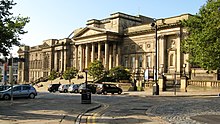Liverpool Maritime Mercantile City
Collectively referred to as the Three Graces, they stand as a testament to the great wealth in the city during the late 19th and early 20th century when Liverpool was one of the most important ports in the world.
[11][12] Behind the Port of Liverpool building is the art deco George's Dock Ventilation Tower, whose design is heavily influenced by Egyptian architectural styling.
[13] Also a part of the site is the old George's Dock wall, which dates from the late 18th century, as well as several memorials, including one built to honour the engineers who remained at their post as the RMS Titanic sank.
Designed by Jesse Hartley and Philip Hardwick and opened in 1846, the Albert Dock warehouses were the first in the world to be entirely fireproof, due to their construction from only iron, brick and stone, with no structural wood.
In the 1980s the area underwent massive regeneration after the creation of the Merseyside Development Corporation and the complex was reopened to the public in 1984, as part of the tall ships festival.
Today they form a focal point for tourism in the city, being home to Tate Liverpool, Merseyside Maritime Museum and The Beatles Story.
Today a centre for commercial activity in the city, the area was included due to the nature of its street development over three centuries and the grandeur of its architecture and monuments.
Amongst the buildings that are focal to this area are St George's Hall, Lime Street station, the Walker Art Gallery, the World Museum Liverpool, the former Great North Western Hotel and the entrance the Queensway Tunnel.
[26] Listed buildings[26] Having received the nomination for the area in January 2003, the International Council on Monuments and Sites (ICOMOS) travelled to Liverpool in September of that year to carry out an evaluation on behalf of UNESCO.
[2] As a result, the Liverpool Maritime Mercantile City was inscribed as a World Heritage Site at the 28th session of the World Heritage Committee in 2004, under the cultural criteria ii, iii and iv:[27] In 2010, the Liverpool Waters development was proposed by The Peel Group as part of the Mersey Waters Enterprise Zone, and envisaged construction of several skyscrapers on the waterfront.
[4] In spite of such warnings, Liverpool City Council continued to approve modernist developments in the area, saying that the moratorium on construction of the piers is unpractical, and others suggested it being incompatible with UK law.
The then Mayor of Liverpool, Joanne Anderson, described it as "incomprehensible" and stated that the World Heritage Site had benefitted from large investments which UNESCO had not appreciated.
[45] Historic England, while it opposed the construction of the stadium on the piers, noted that it was disappointed by the draft decision when it was published, and reiterated its stance a month later, saying that Liverpool's heritage remained internationally important.
[46][47] On the other hand, the director of the Victorian Society was "saddened, but not surprised" by the vote and suggested that the local government officials' comments of conservation at a cost of regeneration were a false dichotomy, while hoping that the decision does not further impact the heritage.









